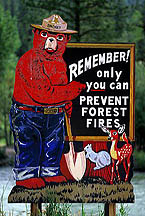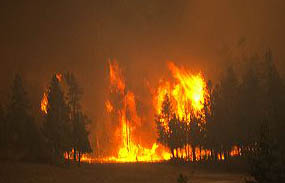Emergency Service
Battling Smoke And Flames With Words And Images
Flying into Boise Tuesday we noticed hundreds of black spots on the desert from past fires as well as the smoke we are all seeing and breathing.

The task of protecting lives and property while battling wildfires has taken on a new face over the past decade or so, thanks to the internet, social media and a plethora of unemployed journalists (who now work for the government).
Just like the war in Afghanistan, the Public Affairs Officer (“fire information officer”) is as much a part of the battle as those on the line. If they screw up, they are likely to feel as much heat as those battling the flames. Their efforts at communication alerts residents in the path of danger, keeps the local media at bay, and creates an “attitude of gratitude” toward the government firefighters, pilots, contractors…which keeps the money flowing from Washington.
Where we once saw local TV newsies playing dress up in yellow shirts and hard hats reporting from the studio, “just back from the fire lines,” we see video and still images produced by the U.S. Forest Service. That is great for the understaffed legacy media outlets and it also allows the government agencies like the BLM and Forest Service to work unhampered sharing their customized message with the public.
They also publish websites bulging with useful information about everything from road closures to progress of firebreak construction along the flanks of the blaze. Here is the official link to the FOREST SERVICE incident site. As more people choose to live in the wilderness the so-called “interface” puts more demand on protecting lives and structures.
GUARDIAN editor Dave Frazier has covered the fire scene for more than 40 years, producing images and text for publications like LIFE, NEWSWEEK, and the NY TIMES.
To insure more advertising-free Boise Guardian news, please consider financial support.
 August 15, 2012
August 15, 2012 

Aug 15, 2012, 6:13 pm
Looks like these fires are a big money maker for a lot of people. Has anyone does a cost/benefit analysis on all of this yet? The fire fighters have got to be running up one heck of a bill.
Too bad we didn’t cut a bunch of trees and run them through a mill in years past. Might have created nice fire breaks.
Aug 16, 2012, 12:04 am
Glad the firefighters are there to help. I think people forget how dangerous it can be.
Aug 16, 2012, 12:50 am
Agree Paul, but would we need so many at such a huge cost if we just did a lot more tree harvesting? Our spending is not sustainable.
Canada is doing what we used to do before the green freaks messed up the USA.
Aug 16, 2012, 6:15 am
I am not so sure that relying on Public Affairs Officers is as good a deal for the public as it is for the agencies. Admittedly, there isn’t likely a lot of “spin” in facts on a fire. However, law enforcement and other guvmint information folks do lots of spin. And the legacy media does little to challenge or question.
Aug 16, 2012, 8:22 am
Twitter and Facebook have also proven very valuable tools, especially for urban interface fires. Both NIFC and the Boise BLM have Twitter accounts that people can subscribe to. Fire officials in southern California have used Twitter alerts to help with evacuations, and it’s worked well for the folks who follow those agencies.
Zippo, I’m not sure you can measure the cost of losing a particular area of public land. There are some inherent personal values that people have, whether it’s their family’s favorite campsite, or the place they planned to go hunting this fall. Then you’ve got airshed and watershed values that are invaluable. I’d love to see more logging in the woods too, but I honestly think those days are mostly over. Unless taxpayers are willing to start subsidizing more mills and timber harvests beyond what they ever did, (and I’m sure I know how that vote would go) then we cannot point to harvest as a viable fire prevention or reduction solution. I wish it were otherwise, but we need to move on from that argument.
Aug 16, 2012, 9:32 am
If you want to see the difference between forests where fire has not been a problem and right next door a huge fire in unmanaged forests caused widespread destruction you should go to ShowLow Arizona.
The Apache land has the brush cleaned up and much of the fuel has been hauled off and made good use of. The Forest service land is a mess (what didn’t burn) with nature taking it’s natural course leading up to a huge fire every few years. Grazeing and selective logging make a lot more cents and dollors too
Aug 16, 2012, 2:27 pm
Anonyvox: Due to poor forest management by several government agencies which can’t find their a$$ with both hands… that priceless land is going up in smoke. Oddly enough, a lot of people are making huge money off of the emergency fire management.
It pays well to waste money for a living.
http://www.cnbc.com/id/48678353
Aug 16, 2012, 2:43 pm
CS- You are right but no need to look in AZ. Idaho Dept of Lands does a great job too. I remember the Blackwell fire in 1994 (later turned into the Corral-Blackwell Complex). The fire started at the border of State and FS land. There was minimal state land burned compared to FS land. IDL alway maximizing returns had timber sales approved for this with in months.
On Topic- I think the inciweb is a great site. Provides lots of information and pictures that you might not get from the media.
Aug 19, 2012, 7:00 pm
Disappointing to see such a strange critique of the media when I know local media crews have been camped out in Featherville for the past week. Dave’s assertion here that we’re seeing more images provided by public agencies may be true – but it is often replacing fire reporting that used to be just a map or a graphic (smaller and remote fires). And while a still image is used here and there, video from these sources is exceedingly rare.
Our crews are still trudging out to the fire lines to report on what is happening first hand. While it certainly isn’t the same level of heroics employed by many firefighters – these folks are working hard to inform people about imminent danger.
Aug 21, 2012, 11:48 am
Why should taxpayers spend millions pay for stupid decisons by people to build their homes in a fire prone area? This is no different from the stupid decisions to build in a flood plain.
Fire is a natural part of ecosystems and supression of fires has a cost down the road. Fire supression efforts in the past have resulted in more and bigger fires today. Fires clear out the build up of forrest crud and undergrowth and release nutirents for new growth. Yellowstone Nation Park and the fires of more than a decade ago are great examples of this need for fires.
Location of homes and defensable permiter are things we all need to practice. Shake roofs and evergreens around your home are an invitation for disaster.
Aug 21, 2012, 10:21 pm
Flyhead, the forest service blm etc. kinda likes it because they get to have huge budgets and lots of toys. Using a chainsaw last year would have saved millions/billions this year… but that makes too much sense.
Editor: What does it mean when they say a fire is 100,000 acres? Is that the size of the burn so far or the size of the area currently on fire? They seem to use the most dramatic descriptor possible rather than just showing us the IR Landsat photos that they have. Seems to be a drama production to free up budget money for next year? What’s your view on the vague and deceptive numbers/language used to describe these fires.
Aug 24, 2012, 11:25 am
Don, The latest Statesman article is using a pic from the inciweb site with no photo credit!
http://www.idahostatesman.com/2012/08/23/2241999/wildfire-update-backburn-operations.html